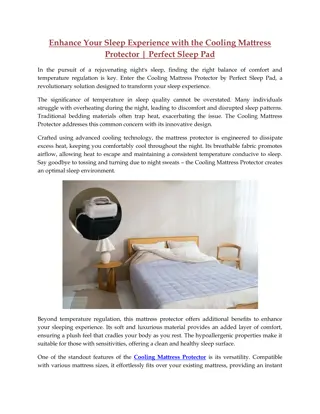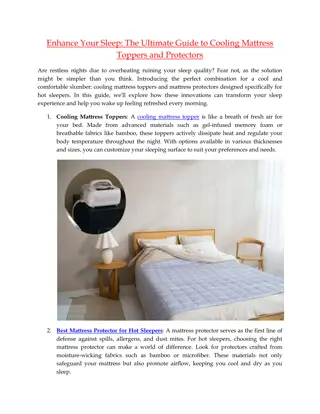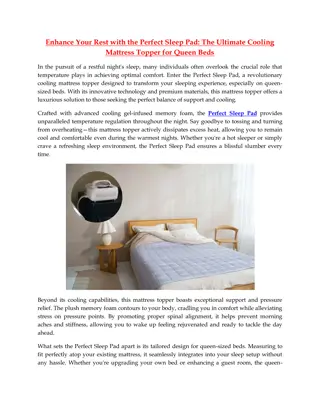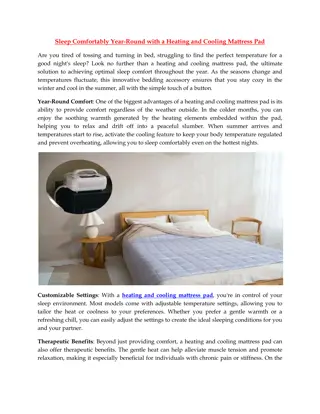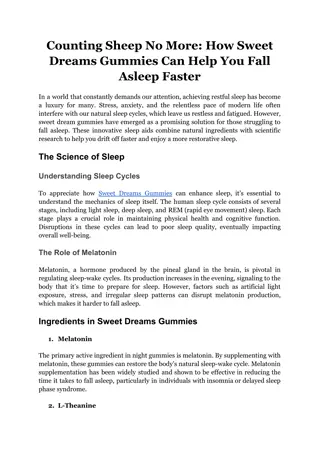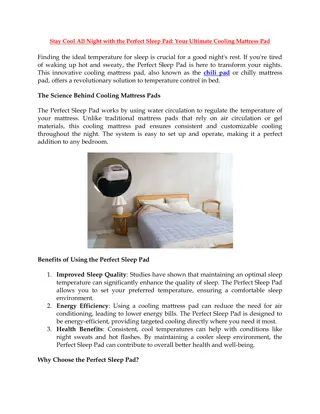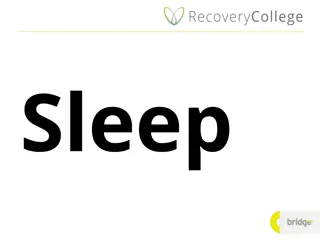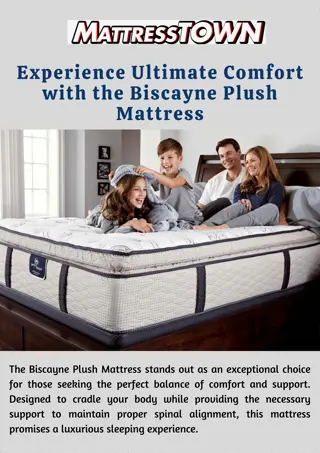Mattress Sales Decline in a Slow Furniture Market – Sleep Number Announces Workforce Reduction
Total furniture and home furnishings sales decreased 11.8% Year-Over-Year in October 2023, impacting mattress sales. Sleep Number, the second-largest mattress chain, plans workforce reductions and store closures for 2024.
Uploaded on Feb 26, 2025 | 0 Views
Download Presentation

Please find below an Image/Link to download the presentation.
The content on the website is provided AS IS for your information and personal use only. It may not be sold, licensed, or shared on other websites without obtaining consent from the author.If you encounter any issues during the download, it is possible that the publisher has removed the file from their server.
You are allowed to download the files provided on this website for personal or commercial use, subject to the condition that they are used lawfully. All files are the property of their respective owners.
The content on the website is provided AS IS for your information and personal use only. It may not be sold, licensed, or shared on other websites without obtaining consent from the author.
E N D
Presentation Transcript
Mattress Sales Decline in a Slow Furniture Market With total furniture and home furnishings sales decreasing 11.8% YOY during October 2023, according to the US Census Bureau, Sleep Number, the second-largest mattress chain, plans to reduce its workforce by 10% and close as many as 50 stores during 2024. Q3 2023 sales and earnings for Tempur Sealy, the third-largest mattress chain, decreased 3.2% YOY in North America. Its pending acquisition of Mattress Firm, the largest mattress chain, will be finalized during 2024. A more positive trend for the mattress & bedding market is the result of a Storyboards study, a photo wall tiles company, of online search terms related to home renovations. Bedroom renovations received strong searches; living room renovations were first.
Comparison of Mattress Buyers According to research from the Better Search Council, Gen Z adults (18 24) are replacing their mattresses at approximately twice the rate of Baby Boomers, at 6.1 years and 12.3 years, respectively. Of course, Gen Z adults will be consumers for many more years than Baby Boomers, meaning Gen Z adults have the potential to generate more revenues for the mattress industry. Gen Z adults said they would spend $683 for a replacement mattress compared to $1,074 for Baby Boomers; however, with Gen Zers replacing theirs twice as often as Baby Boomers, they would spend $1,366 for two replacements when Baby Boomers replace one.
Mattress Purchasing Trends According to Provoke Insights, Furniture Trends: Fall 2023/Winter 2024 survey, 68% of respondents said they planned to buy furniture, and almost half (47%) said they planned to spend more than $1,000 on furniture during the next year. A mattress at 32% and bedroom furniture at 31% were the second and third furniture categories that consumers told Provoke Insights they planned to purchase during the next year. An August 2023 YPulse survey of US and Canadian consumers found 31% of Gen Z adults and 40% of Millennials planned to buy bedding and bath supplies during the next year.
Sleep Patterns Affecting Mattress Buyers US adults continue to face sleep challenges. A December 2022 survey conducted by Fluent Research for the International Sleep Products Council (ISPC) revealed 53% of them sleep six hours or less during a typical night and 48% said they weren t receiving enough sleep. 44% said it was very or somewhat difficult to fall asleep and 50% to stay asleep. Women were more likely to experience these difficulties than men. A majority of women (54%) said they don t receive enough sleep. Comfort at 72% is the primary factor for consumers when choosing a mattress, followed by low price (13%), reputation of mattress brand (8%), easy to assemble (5%), free trial at home (2%) and other (1%).
Sleep Disruptions and Solutions Of the adults surveyed by Fluent, 39% said their sleep is negatively affected by body pain or aches, 36% by worrying about money or finances, 28% by being too warm, 20% by being too cold and 18% (tied) by worrying about my work and outside noise. Gen Xers at 40%, Gen Zers at 39% and Millennials at 38% said worrying about money was a primary disruption of their sleep compared to 29% of Baby Boomers. Body pain or aches was first among Gen Xers at 42% and Baby Boomers at 43%. Women face more challenges than men to experience a good night s sleep: body pain or aches, 45% and 32%; snoring partner, 20% and 10%; pets waking them, 18% and 13%; and children waking them, 15% and 8%, respectively.
Sustainability Is Important to Consumers As with many products, half of consumers surveyed by the Better Sleep Council during July and August 2023 said mattresses with sustainable materials would influence their purchase of a mattress from a specific retailer. Conversely, the survey found almost half of retailers didn t think sustainability had much influence on what mattress brands they stocked. Most of the retailers admitted to a lack of knowledge about sustainability and discussing it with customers. Almost three-quarters (71%) of the surveyed retailers said they needed more educational materials from manufacturers to improve their knowledge about sustainable materials in mattresses and be recognized as an expert by customers.
Advertising Strategies With bedroom renovations among the plans of consumers during 2024, consider a weekend promotion that includes an onsite designer who can share and recommend renovation ideas. Include a weekend-only discount for items the designer recommends. Baby Boomers will spend an average of more than $1,000 for a replacement mattress and many have the money to spend that much or more. Create ad messages that emphasize the importance of a good mattress as one ages and feature mattresses in that price range. Furniture and mattress stores that also specialize in bedding accessories and offer a broad inventory of products can promote this distinction as research shows mattress buyers find it convenient to purchase bedding accessories with a mattress purchase.
New Media Strategies Use social media to explain the quality of value-priced mattresses to attract Gen Z adults who spend an average of $683 for a replacement mattress. Show price comparisons of the savings consumers can realize by choosing value-priced mattresses. Create content appropriate to TikTok and other social media platforms Gen Zers use. Share bedroom-style ideas to attract young adults who are renters or are renting their first apartment. Offer a digital coupon for featured items and/or bedding accessories. To attract a maximum number of Gen Z and Millennial mattress buyers, use social media to explain how the mattresses the store sells are made from sustainable materials and that the store supports and offers mattress recycling.




